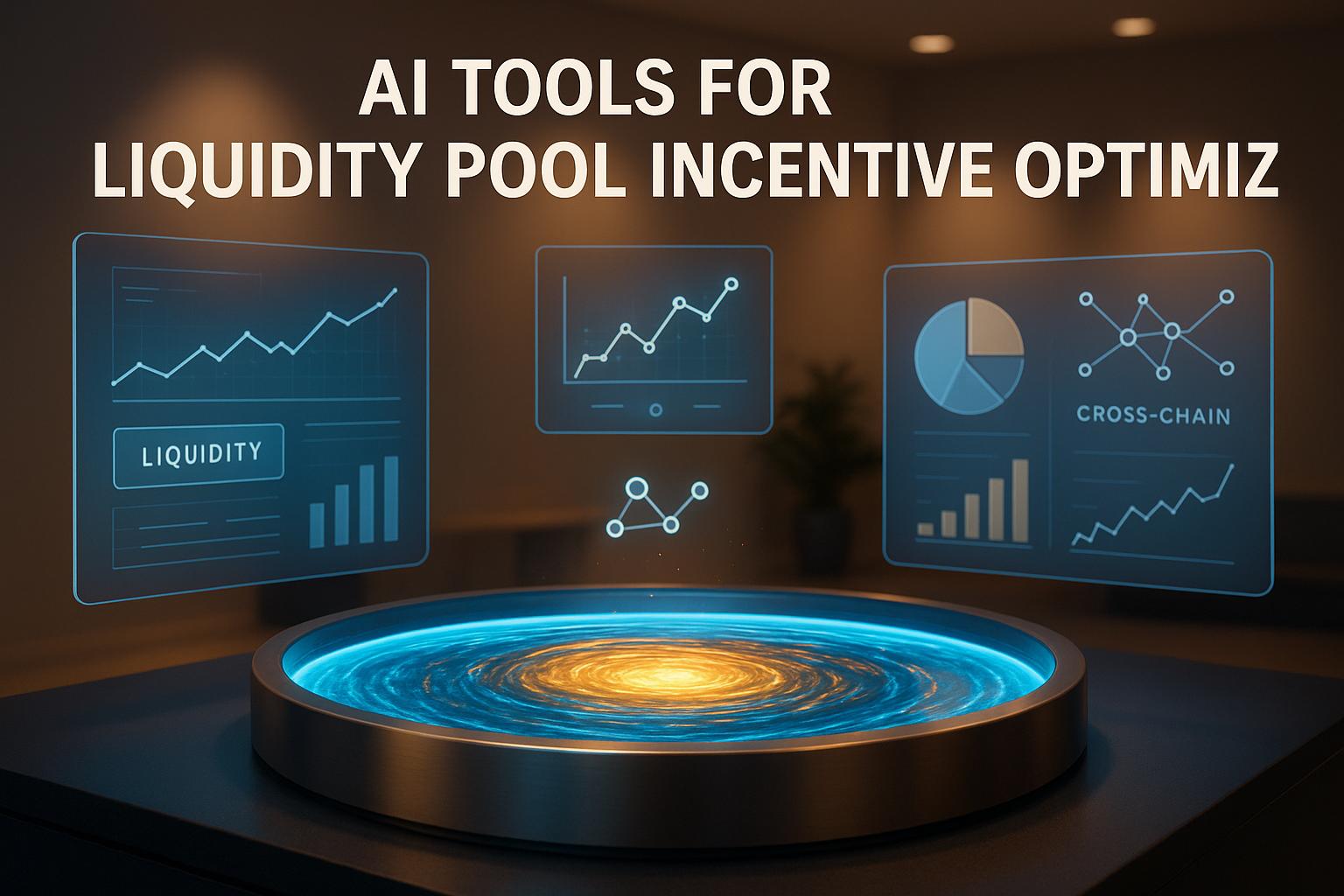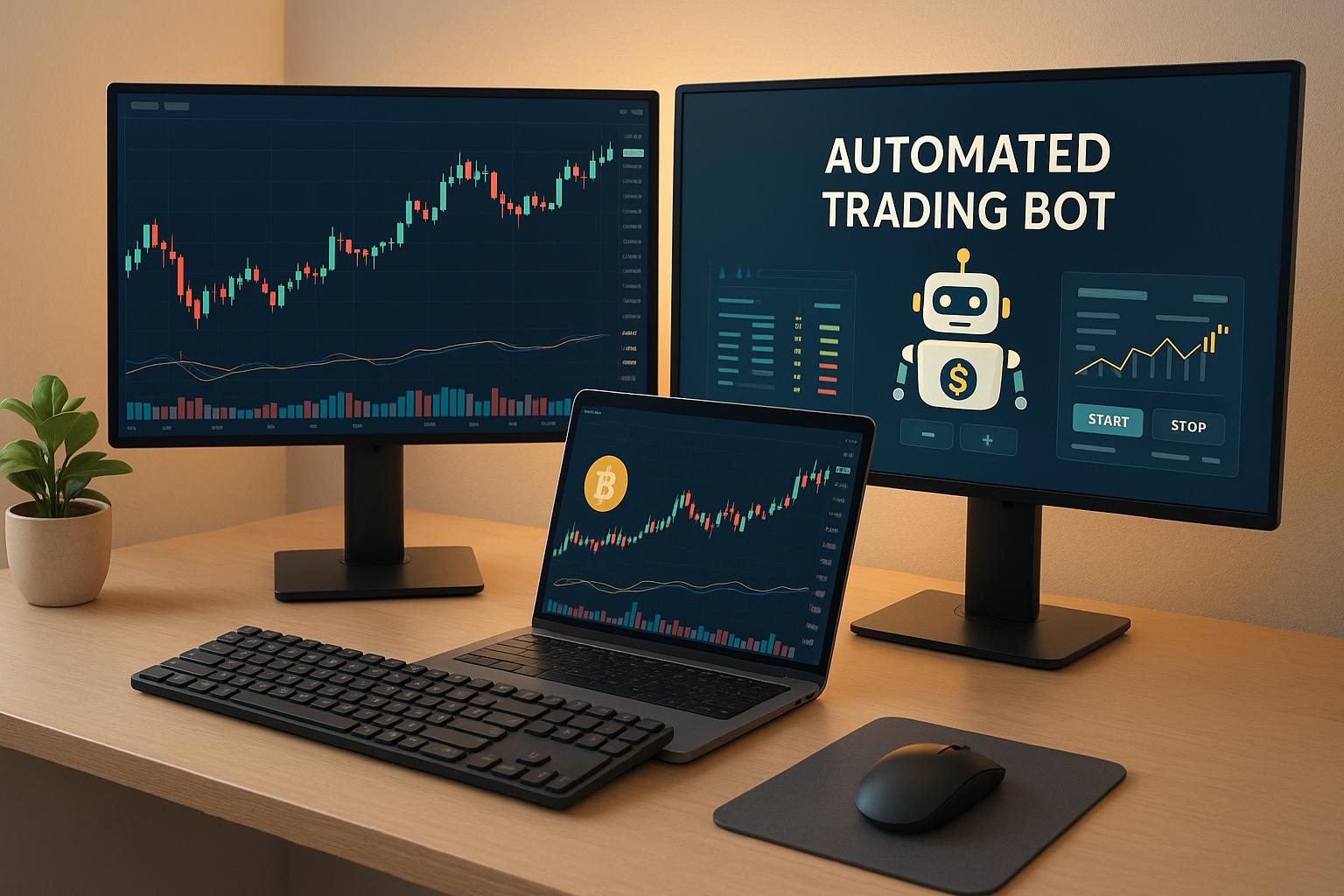Flash loans are instant, no-collateral cryptocurrency loans that must be repaid within the same blockchain transaction. MEV (Maximal Extractable Value) bots use flash loans to execute complex trading strategies like arbitrage and liquidation without needing large upfront capital. These bots borrow funds, complete trades, repay the loan, and pocket profits - all in one atomic transaction. Here's how it works:
- How Flash Loans Work: Borrow large sums instantly with no collateral; repay within the same transaction or the loan reverses automatically.
- MEV Bot Strategies: Arbitrage (price differences across exchanges), liquidation (covering shortfalls), and sandwich trading (front-running and back-running).
- Efficiency and Speed: MEV bots rely on private nodes, real-time mempool scanning, and dynamic gas fee adjustments to stay competitive.
- Challenges: High competition, gas fee optimization, network congestion, and smart contract vulnerabilities can hinder success.
- Risk Management: Bots use advanced algorithms, validator connections, and rigorous contract audits to minimize risks.
Quick Overview of Flash Loan Pros and Cons
| Advantages | Limitations |
|---|---|
| No collateral required | Fierce competition drives up costs |
| Enables large trades with little capital | Smart contract vulnerabilities |
| Executes within a single transaction | Network congestion impacts performance |
| Contributes to market price stability | Failed transactions still incur gas fees |
Flash loans have transformed DeFi trading, enabling efficient, high-speed operations for MEV bots. However, success demands technical expertise, precise execution, and constant adaptation.
How Flash Loan Integration Works
Flash Loan Basics
Flash loans rely on a concept called atomicity, meaning every step in a blockchain transaction must either succeed entirely or be reversed completely. This unique feature allows borrowing without collateral, provided the loan is repaid within the same transaction. Smart contracts handle the entire process - issuing the loan, managing it, and ensuring repayment. If anything goes wrong along the way, the smart contract automatically cancels the transaction, safeguarding the lender's funds.
Flash Loan Integration Process
The integration of flash loans builds upon this atomic nature and follows a streamlined three-step process. First, an MEV (Miner Extractable Value) bot scans the market for profitable opportunities, like price differences between decentralized exchanges. Once it identifies a viable opportunity, the bot takes out a flash loan to fund the trade. In the next step, the bot uses the borrowed funds to execute the trade - this often involves buying an asset on one exchange and selling it immediately on another to pocket the profit. Finally, the profits from the trade are used to repay the loan, including any associated fees. For instance, one flash loan-enabled back-running trade on Solana reportedly generated about $1.9 million in profit.
Built-in Risk Protection
Flash loans come with built-in safeguards to minimize risk. A critical safety feature is the automatic reversion mechanism. If the MEV bot fails to repay the loan within the transaction, the smart contract reverses all actions, ensuring the borrowed funds are returned to the lender and nullifying any trades that were made.
Additional risk controls include precise gas management - MEV bots need to estimate gas costs carefully and keep an eye on real-time gas prices. To prevent front-running (where others intercept profitable trades), these bots often use platforms like Flashbots to send transactions directly to miners. These measures help reduce the chances of losing profitable opportunities to competitors. Even when a flash loan attempt fails, the only loss incurred is typically the gas fees, making it possible for bots to pursue high-reward trades while keeping risks in check.
Flash Loan Workflow Steps for MEV Bots
Finding Profitable Opportunities
MEV bots are always on the hunt for opportunities, leveraging their flash loan capabilities to scan blockchain networks for arbitrage and liquidation possibilities. They keep a close eye on the mempool and analyze smart contract data, including liquidity pools, token movements, and execution logic, to pinpoint high-value chances for profit.
To stay competitive, these bots rely on real-time data feeds from the mempool to evaluate each incoming transaction. Their impact is significant - MEV bots are responsible for half of the trading volume on platforms like Uniswap. Once they detect a viable opportunity, the flash loan process kicks into gear.
Running the Flash Loan Process
When a profitable opportunity is identified, the bot executes a sequence that bundles borrowing, trading, and repayment into a single atomic transaction. This involves combining multiple function calls into one seamless operation.
The process begins with the bot borrowing large sums through a flash loan. For instance, a bot might utilize MakerDAO's 0% DAI flash loans to execute arbitrage trades swiftly. During this stage, custom smart contracts come into play, enabling the bot to perform several actions simultaneously. If the trade is successful, the bot repays the loan and keeps the profit; if not, the entire transaction is reversed automatically, ensuring no loss beyond the gas fees.
A striking example of this efficiency occurred in January 2023, when a bot named 2Fast turned 703 SOL (around $70,000) into 19,035 SOL (approximately $1.9 million) in just 20 seconds using a back-running strategy on dogwifhat (WIF) trades.
To maximize their performance, some MEV bots go a step further by "bribing" blockchain validators to prioritize their transactions. This requires direct connections to validators, ensuring their trades are executed with optimal speed and accuracy. Real-time tracking then verifies the results, helping bots address any issues quickly and efficiently.
Tracking Results and Managing Failures
Monitoring and handling failures are essential for MEV bots to operate effectively. These bots continuously track transaction statuses and are equipped to manage unexpected execution problems.
Gas fees are a key factor in success. Bots use tools like EthGasStation to monitor gas prices and adjust transaction timing accordingly. Additionally, their smart contracts include fallback functions to handle unforeseen scenarios without wasting excessive gas.
If a transaction fails, the atomic structure of flash loans ensures the entire operation is reversed, limiting the loss to the gas fees spent on the failed attempt. This setup allows MEV bots to take on high-reward trades while keeping risks under control.
Performance tracking tools are constantly in action, sending automated alerts when significant market changes or errors occur. This robust infrastructure enables MEV bots to execute complex strategies - such as sandwich trading or flash loan arbitrage - with the speed and precision needed to turn a profit.
Flash Loan Arbitrage | Aave Flash Loan Tutorial

sbb-itb-00c75f7
Common Problems and How to Fix Them
When diving into the flash loan workflow, several challenges can arise, making execution tricky.
Main Flash Loan Challenges
One of the biggest hurdles for MEV bots is gas fee optimization. Bots need to position their transactions precisely within blocks to secure profits. However, gas price fluctuations can quickly turn a promising opportunity into a losing one. Even minor miscalculations in gas estimation can result in failed transactions or reduced profits.
Competition among bots adds another layer of difficulty. Multiple MEV bots often chase the same arbitrage opportunities, creating intense bidding wars. This competition drives up transaction costs and makes success heavily dependent on speed. Between 2019 and 2022, over $675 million in MEV profits were generated on the Ethereum blockchain alone, with the total MEV market across all blockchains surpassing $1 billion.
Then there’s the risk of smart contract vulnerabilities. A notable example occurred in September 2022 when a bot named 0xbad executed an arbitrage transaction that earned 800 ETH (worth over $1 million at the time). Unfortunately, a hacker exploited a flaw in the bot’s code, not only wiping out its profits but also stealing an additional 300 ETH from the bot’s wallet.
Lastly, market volatility can ruin opportunities between the moment they’re identified and when they’re executed.
Solutions That Work
Addressing these challenges requires a combination of technical strategies and proactive risk management.
Advanced gas algorithms are a powerful tool for tackling gas fee issues. Bots can use dynamic gas estimation to monitor network conditions in real time, ensuring they adjust their transaction timing and pricing accordingly. Optimizing smart contract code also plays a critical role - this includes reducing storage usage, using smaller data types, and cutting out unnecessary computations to lower gas costs.
Building relationships with validators through direct validator communication can prioritize transactions and minimize front-running risks. Platforms like Flashbots on Ethereum or Jito Labs on Solana make this possible. For example, in January 2023, the MEV bot 2Fast incentivized 890 SOL to a validator named Figment, enabling it to transform 703 SOL into 19,035 SOL in just 20 seconds.
To avoid costly mistakes, rigorous smart contract audits are essential. These audits should focus on identifying potential exploits, implementing access controls, and adding emergency stop mechanisms. They should also include testing failsafe systems to ensure funds can be recovered in case of an exploit, such as the one that impacted the 0xbad bot.
Real-time monitoring and dynamic strategy adjustments are key to staying ahead of market changes. WebSocket connections can provide faster market data updates than traditional REST APIs, while automated alert systems can notify operators of market shifts or execution errors. Risk management algorithms should continuously evaluate profit and loss potential, incorporating stop-loss mechanisms to limit exposure.
Finally, successful MEV operators use MEV protection techniques to shield their transactions from front-running. Privacy-enhancing methods and routing transactions through Flashbots help maintain the secrecy needed for profitable MEV strategies. Proper nonce management prevents transaction replay attacks, and robust error handling ensures that failed transactions don’t spiral into larger issues .
These strategies have proven highly effective. For instance, the MEV bot operator known as "jaredfromsubway" reportedly earned over $1 million in just one week by executing sandwich attacks on Pepe and Wojak memecoin trades. However, staying successful requires constant refinement and adaptation of these methods to keep up with evolving market dynamics.
Pros and Cons of Flash Loan Integration
Let’s dive into the upsides and challenges of integrating flash loans into MEV (Maximal Extractable Value) operations. While they open doors to exciting opportunities, they also come with their fair share of hurdles.
Benefits of Using Flash Loans
One of the biggest perks of flash loans is capital efficiency. They let traders access large amounts of capital without needing upfront collateral. For example, platforms like Aave offer flash loans with borrowing costs as low as 0.09%. This makes it possible for smaller operators to execute large-scale arbitrage trades without locking up their own funds.
Flash loans also level the playing field. Traditional MEV strategies often favor traders with significant capital reserves. Flash loans change the game by allowing traders with limited resources to compete against well-funded operators. This opens the door to new and creative strategies that might not have been feasible otherwise.
The speed and efficiency of flash loans make them a perfect fit for MEV operations. Since they execute within a single transaction block, they align seamlessly with the fast-paced nature of arbitrage. Traders can quickly capitalize on fleeting price discrepancies across decentralized exchanges. For instance, during the first half of 2023, an Ethereum bot reportedly generated $34 million in just three months through sandwich attacks and arbitrage strategies.
Beyond individual profits, flash loans can contribute to market efficiency. By correcting price differences across decentralized exchanges, they help stabilize markets and ensure fairer pricing.
Drawbacks and Limitations
However, flash loan integration isn’t without its challenges. Intense competition is one of the biggest hurdles. With multiple bots targeting the same opportunities, transaction costs can skyrocket. Success often boils down to execution speed measured in milliseconds. As the MEV market has grown, competition has become fiercer, with total Realized Extractable Value surpassing 416,000 ETH (over $500 million) since Ethereum’s transition to Proof of Stake.
Another major concern is technical complexity and vulnerability risks. Flash loan operations rely on smart contracts, which, if poorly coded or exploited, can lead to catastrophic losses.
Network dependency adds an unpredictable layer of risk. Success hinges on factors like gas prices, network congestion, and block confirmation times. Even minor delays can turn a potentially profitable trade into a loss.
Then there’s the issue of failed transaction costs. In competitive environments, unsuccessful trades still rack up gas fees, which can quickly add up during periods of high network congestion.
Lastly, ethical concerns and potential backlash pose longer-term risks. MEV bots, while profitable, can undermine the transparency and fairness of blockchain systems. By favoring operators with more resources and expertise, they may contribute to market instability, triggering stop-losses for unsuspecting traders.
These challenges underscore the importance of careful planning and strategy optimization for anyone considering flash loan-enabled MEV operations.
Pros vs Cons Comparison
Here’s a quick breakdown of the key advantages and limitations:
| Advantages | Limitations |
|---|---|
| No need for collateral to access large capital | Fierce competition increases costs |
| Low borrowing costs (e.g., 0.09% on Aave) | High technical complexity and vulnerability risks |
| Broadens access to MEV strategies | Relies on network conditions (gas prices, block times) |
| Executes transactions rapidly in a single block | Failed transactions still incur gas fees |
| Proven potential for high profits | Raises ethical concerns and risks regulatory scrutiny |
| Contributes to market price stability | Requires deep technical expertise to succeed |
| Enables sophisticated, multi-step strategies | Volatility can wipe out opportunities quickly |
Flash loan integration offers immense potential, but it’s not for the faint of heart. Success requires a combination of technical know-how, risk management skills, and the resources to withstand the challenges of a highly competitive and unpredictable environment.
Conclusion
Flash loans have revolutionized the way MEV bots operate, allowing them to execute complex strategies without the need for upfront capital. This has opened the door for traders of all sizes to tap into advanced arbitrage opportunities without requiring significant initial investments.
Key Takeaways
The real power of flash loans lies in their ability to provide instant access to large amounts of capital without requiring collateral. Stories like the 2Fast bot, which turned 703 SOL into 19,035 SOL, highlight the immense potential of these strategies when executed with precision.
However, success in this space isn’t just about access to capital - it demands technical skill and efficient gas management. The competition is fierce, with Total Realized Extractable Value surpassing 416,000 ETH (over $500 million) since Ethereum transitioned to Proof of Stake. In this environment, speed and accuracy are critical.
When exploring flash loan strategies, it’s important to rely on trusted protocols like Aave, dYdX, and Uniswap. Understanding their unique terms and keeping a close eye on market conditions can make a significant difference in the success of your approach.
Enhancing Flash Loan Strategies with AIQuant.fun

Building on these foundations, integrating AI-powered tools can take flash loan strategies to the next level. Platforms like AIQuant.fun use advanced trading agents to scan multiple decentralized exchanges for arbitrage opportunities that might escape human detection. This combination of speed and precision creates a more efficient trading process.
AIQuant.fun’s models utilize reinforcement learning, adapting to market conditions and historical trends to make more accurate predictions and optimize transaction routes. This is particularly useful in flash loan operations, where minimizing gas fees and slippage is key to profitability.
Additionally, AI tools can monitor for potential smart contract vulnerabilities and dynamically adjust strategies across multiple platforms. By automating execution and providing advanced analytics, these systems allow traders to focus on high-level strategy while the technology handles the heavy lifting. This synergy between automation and execution is shaping the future of MEV strategies.
"MEV bots represent a fascinating combination of blockchain transparency, technical innovation, and financial strategy. They use mempool data and advanced algorithms, transforming transaction processing and profit extraction in crypto markets."
- Anatol Antonovici
FAQs
How do MEV bots leverage flash loans to execute arbitrage without upfront funds?
MEV bots take advantage of flash loans to access substantial amounts of capital temporarily, enabling them to execute arbitrage strategies without needing upfront funds. What makes these loans so special is that they must be borrowed and fully repaid within the same blockchain transaction.
Here’s how the process unfolds: The bot spots price differences for the same asset across various exchanges. Using the flash loan, it buys the asset at a lower price on one exchange and sells it at a higher price on another, pocketing the profit. If the trade goes as planned, the loan is repaid, and the bot keeps the earnings. If the trade doesn’t pan out, the transaction is automatically reversed, ensuring no financial loss occurs.
This approach allows MEV bots to capitalize on market inefficiencies with precision and minimal risk, making them a powerful tool in the fast-paced world of cryptocurrency trading.
What are the key risks of using flash loans in MEV bots, and how can they be addressed?
Flash loans in MEV operations carry some serious risks, particularly when it comes to security and exploitation. One of the biggest concerns is flash loan attacks, where malicious actors take advantage of the atomic structure of these loans to manipulate decentralized finance (DeFi) protocols. This can lead to financial losses through tactics like front-running or tampering with oracles. Another major issue is governance attacks, where flash loans are used to temporarily gain control over voting mechanisms, potentially changing protocol rules or even draining treasuries.
To address these risks, several strategies can be implemented. For example, private mempools can help shield transaction details from public view, reducing exposure to front-running. Governance models can also introduce safeguards such as voting power delays or quorum requirements to make it harder for bad actors to seize control. On top of that, advanced tools designed to detect and block suspicious activity in real time can significantly improve security. While flash loans provide powerful opportunities for MEV bots, having strong protections in place is crucial to ensure their safe and effective use.
How do gas fees affect the profitability of MEV bots using flash loans, and how can these costs be reduced?
Gas fees are a key factor in determining how profitable MEV bots can be, especially those that use flash loans. These bots often operate in fiercely competitive environments, and high gas fees - particularly during network congestion or when multiple bots are vying for the same transaction - can quickly erode potential profits. Even deals that look promising at first glance can become far less appealing once gas costs are factored in.
To keep gas expenses in check, MEV bots can use smart strategies like transaction batching, which bundles several operations into a single transaction to cut down on fees. Another approach is dynamic gas pricing, where bots adjust their fees in real time to remain competitive without overspending. Additionally, executing transactions during off-peak hours, when network activity is lower, can help reduce costs. By carefully managing gas fees and using flash loans wisely, MEV bots can boost their profitability while keeping overhead costs manageable.


